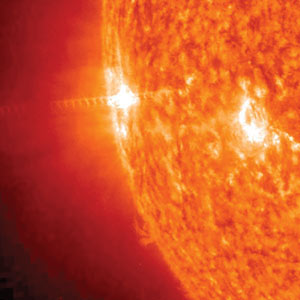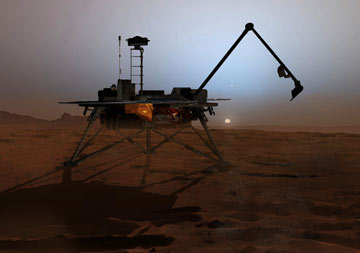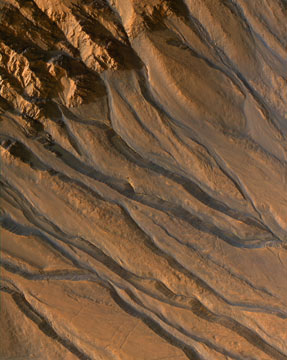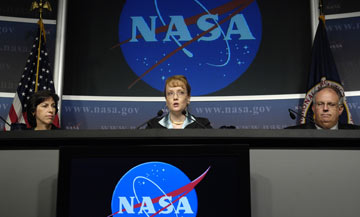|
FEATURE — Planetary Exploration
2007 Highlights Home page >> Planetary Exploration Features >> Planetary Exploration Highlights
Speaking Solar With Dan Baker
Talking Mars With Richard Zurek
Weathering more than just the storm at NASA
Planetary Exploration: Other Highlights
Speaking Solar With Dan Baker
 NASA/GSFC |
| Using the STEREO spacecrafts’ high-resolution cameras, researchers can zoom in on areas of interest, such as this pair of active regions on the surface of the sun. On June 29 and 30, they captured numerous instances of low-intensity flaring activity. |
Early next year — sometime around March is a good bet — activity on the sun, such as flares and solar storms, will be at a dead minimum. Then, roughly five years from now, the sun’s activity will start ramping up again as it moves into the upswing of its 11-year solar cycle (see Geotimes online, Web Extra, April 30, 2007).
So why, if we’re in a solar minimum, was there a big solar storm last December? Researchers are not sure, but thanks to some new observations over the last year, “we are getting a much clearer picture,” says Dan Baker, director of the Laboratory for Atmospheric and Space Physics at the University of Colorado at Boulder, and professor of astrophysical and planetary sciences there.
“This year, we’ve seen a lot more attention paid to new missions that are giving us new views of the sun and how the disturbances from the sun affect humans and human technology,” Baker says. Solar storms affect everything from airplanes and satellites to cell phones and the global positioning system. These storms can also affect electric grids, as happened during the infamous Halloween 2003 solar storms. “There are just a huge number of technologies that have come a long way in the last decade or so and are just going to become more important over coming decades,” Baker says, “and they probably all … could be affected by space weather and a more disturbed sun.”
As we look to the future, Baker says, we also have to consider how solar storms might affect astronauts on the moon or Mars: Spacecraft in transit or astronauts out on a planet’s surface could face extreme radiation from strong solar storms, he says. We don’t know the strongest past storm, nor even know the strongest storm possible, so it’s hard to say what power of storm has to be planned for.
Now researchers are trying to determine whether they can use past events to predict future storms and strengths. Part of that involves getting better observations, which they’re able to do thanks to the recently launched STEREO mission. STEREO is a set of two identical satellites: One will move ahead of Earth in its orbit while the other will move behind it, allowing researchers to get a three-dimensional, stereoscopic view of what is coming at us from the sun. Researchers are also starting to get a “dim view of what’s happening on the far side of the sun,” Baker says, through higher-resolution magnetic measurements of the sun’s properties. This should help “us to see what’s coming at us,” he says.
These new, improved observations are also being used in models, Baker says. Researchers are working, he says, “to take daily (or even more frequent) observations of the sun, use empirical and physics-based models to propagate these things out to … give us a reasonably accurate picture of how the solar wind flowing out from the sun is going to behave, what’s going to hit the Earth, and again, to kind of work toward this predictive capability.” Such work, he says, “is starting to give us at least a shot at predicting three or four days in advance what’s going to be reaching Earth, which is quite a useful thing for many purposes.”
Increasing predictive capabilities is something many people are interested in. At the Space Weather Enterprise Forum in Washington, D.C., this year, policymakers and researchers joined with industry to discuss what NASA, NOAA, the National Science Foundation, the U.S. Air Force and other government agencies are learning about the sun and how they are developing a “more effective national space weather program,” Baker says. What impressed Baker most, he says, is that various industries, such as the satellite, airline and electrical power grid industries, are all beginning to recognize more openly that these are problems that affect them. And with the latest research indicating that the next solar cycle could be 50 percent stronger than the last one, they are paying more attention, Baker says. However, we can’t be sure what the next cycle will bring — after all, he says, “as Yogi Berra said, ‘Predictions are hard. Especially about the future.’”
Links:
“Sun cycle to flare back up in 2008,” Geotimes online, Web Extra, April 30, 2007
Laboratory for Atmospheric and Space Studies
Talking Mars With Richard Zurek
 NASA/JPL-Caltech/University of Arizona |
| This artist’s concept depicts NASA’s Phoenix Mars Lander just before its May 25, 2008, projected touchdown on the arctic plains of Mars. Pulsed rocket engines control the spacecraft’s speed during the final seconds of descent. One of its first actions will be to sample below the soil surface to see how deep the planet’s ice is. The lander launched in August. |
With so many new missions launched to Mars, it probably shouldn’t surprise us that so much of the space talk this year was about the red planet. And despite tantalizing data, the big question — the role of liquid water on Mars — still remains elusive.
But clues are piling up. The Mars Reconnaissance Orbiter launched in 2005 is providing “tremendous” volumes of high-quality, high-resolution data, the Mars Odyssey and Mars Express spacecraft are still going strong, the Phoenix lander mission is on schedule to land on Mars in May 2008, and like the Energizer Bunny, the Mars Exploration Rovers, Spirit and Opportunity, just keep going and going, says Richard Zurek, chief scientist for the Mars Exploration Program and project scientist for the Mars Reconnaissance Orbiter at NASA’s Jet Propulsion Laboratory at Caltech in Pasadena, Calif. “It’s been a year of exciting discoveries on Mars,” he says.
This fall, Zurek sat down with Geotimes managing editor Megan Sever to discuss the latest on Mars.
MS: What’s been the biggest story of the year?
RZ: I’d like to give you a nice little sound bite that says, “Oh it’s great, there’s water gushing on the surface of Mars,” but what we’ve found is that it’s a lot more complicated than that. We’ve found that some new gully deposits weren’t quite what they seemed, and yet at the same time, we see evidence that water has operated on the surface and that groundwater has operated near the surface. Also, we’ve gotten clues to the recent geologic history by looking at the polar ice deposits in some radically new ways. So water is still the story, but its history is more complicated than what we might have thought.
The Mars Global Surveyor mission sent back exciting images of things that had changed on Mars’ surface [in just a few years]. One of those was that it recorded new craters on the planet — and that’s great, because that helps us calibrate the cratering rates. It is also exciting from the standpoint that when you get an impact, you expose a subsurface that has been protected from impacts and weathering for perhaps millions of years.
One big thing that happened this year was a major dust storm that covered much of the planet in June and July. Since the rovers are solar-powered, there were worries about losing the rovers during that period of reduced sunlight at the surface. But it all worked out in the end, and the rovers are still going.
MS: We’ve heard variously this year that there is and isn’t definitive evidence of water on Mars (see Geotimes, February 2007). What’s the real story?
RZ: Well, in addition to the cratering, the Mars Global Surveyor pointed out these gullies [in 2000], which the Mars Reconnaissance Orbiter has also zoomed in on with even higher resolution. Gullies are fascinating because geologically they look young. And, they look like they’re formed by water. The excitement rose even further when we saw two bright deposits had formed on the planet during the time that the Mars Global Surveyor was operating.
 NASA/JPL/University of Arizona |
| This image from HiRISE on the Mars Reconnaissance Orbiter shows gully channels in a crater in the southern highlands of Mars. The gullies, originally filmed by the Mars Global Surveyor seven years ago, show meandering and braided patterns typical of water-carved channels. However, thanks to the extremely high-resolution images taken this year by HiRISE, researchers now think these particular gullies were not carved by water, but by dry avalanches. |
Now what said this might be water? Well, one was that the channel had certain flow-like features, but you can get a dry avalanche of material … so that was the question — dry avalanche or water?
With an imaging spectrometer [on the Mars Reconnaissance Orbiter], we could tell that the bright deposit had the same chemical signature as the dust deposits farther up on the wall of the crater. So that argued that it was more of a slide, rather than a flow. The higher-resolution camera indicated that the channel slope was steep enough that it was consistent with a dry avalanche. So the best explanation today for those two changes that we saw, is that they’re dry avalanches of material. These results were reported in Science.
But in the same paper, the researchers also reported that other gullies are on slopes that are too shallow for dry avalanches, and some of those have distinct water features [such as] a braided streambed. And there’s material that is moved in a way that you’d expect for water flow as opposed to a landslide of material going down a slope.
MS: What have we learned about Mars’ polar ice caps?
RZ: The ice caps are about one to two kilometers thick. For a long time, we tried to estimate the amount of ice in the caps. From the new gravity measurements, we can estimate how much mass is in the polar caps. From the radar, we now have the volume of the ice caps, so we can estimate the density of the whole stack of ice. [The density] is very close to what you would expect if this was largely water ice all the way through the caps. We knew it was water ice at the top, but we couldn’t be sure what was underneath.
We’ve also seen that distinct layers of ice extend all through the cap, suggesting that whole layers form when the global climate changes. Thus, these are events that occur over very large areas, over hundreds of square kilometers and beyond.
The new data also show us that the rocky surface below [the northern ice cap] is not deformed in the way we would expect [from a load of ice more than a kilometer thick]. That says one of two things: Either the deposits are still very young — that is they’ve been loaded up so recently that geologically the surface below hasn’t had time to respond enough that we can measure it. Or, it says that that surface is much different from what we expected.
MS: Where do we suspect the water is coming from on Mars?
RZ: The picture that’s emerging now isn’t one of an ocean and a hydrologic cycle with rainfall extending over the land, but one of which there’s a very icy crust over much of the planet with water that’s being melted somehow and released. The latest evidence points more to episodic, transitory surface water released by some sort of heat … from subsurface hotspots, a geothermal hot spring, a volcano or perhaps an impact event. Is this the whole story? No, we’re still learning.
Links:
“Water responsible for martian landscape?” Geotimes, February 2007
“Martian pole boasts icy detail,” Geotimes, May 2007
“Mars had explosive, watery past,” Geotimes, July 2007
“More on Mars,” Geotimes, August 2007
Mars Exploration Program at NASA Jet Propulsion Laboratory
Weathering more than just the storm at NASA
 NASA/Bill Ingalls |
| On July 27, Ellen Ochoa, director of flight crew operations at NASA Johnson Space Center (left), Shana Dale, NASA deputy administrator (center), and Richard S. Williams, chief health and medical officer at NASA Headquarters (right), released findings on astronaut health and behavior from two independent studies conducted over the previous five months. |
In addition to budget woes and program cuts, NASA faced more than its fair share of problems this year — particularly with its public image. Some analysts wonder if NASA can polish up its tarnished image, while others suggest that focusing on science is how the agency will overcome its troubles.
The image problems began in February, when astronaut Lisa Nowak was arrested after driving from Texas to Florida with the alleged intention of assaulting or kidnapping a romantic rival in a love triangle with another astronaut. Nowak was arrested and has been released on bail pending trial on charges of felony attempted kidnapping and burglary with assault and misdemeanor battery.
The problems continued in April, when a disgruntled NASA contractor, Bill Phillips, stormed an office at the Johnson Space Center in Texas, shot and killed a NASA employee, held another employee hostage and then killed himself.
In June, the House Science Committee asked the Department of Justice to look into NASA’s general counsel for “allegedly destroying records of a meeting between the inspector general and the space agency’s administrator,” according to an article on Forbes’ Web site Aug. 15. Others in Congress apparently asked for NASA’s inspector general to resign following a government review that found that he had “abused his authority,” Forbes reported.
In mid-June, the International Association of Machinists and Aerospace Workers, which supports various NASA operations, including flight operations at Cape Canaveral, Fla., went on strike. In August, the union filed a lawsuit against NASA for interfering with contract negotiations between the union and the United Space Alliance, a joint venture of Lockheed Martin and Boeing, according to a union press release.
In July, NASA investigated allegations that a NASA subcontractor had sabotaged the space shuttle Endeavor by cutting wires in a computer that was supposed to be aboard the space shuttle. The wires would not have been a threat to astronauts, NASA said, according to The Houston Chronicle, July 27.
Also on July 27, NASA released the findings of two independent five-month assessments of astronaut health and behavior (initiated in the wake of the Nowak scandal). One of the studies found that a couple of astronauts had improperly used alcohol prior to flight, prompting fellow astronauts and flight surgeons to raise concerns. NASA says that it was unaware of any such incidents, and further investigation found “no evidence” to support claims that astronauts were impaired by alcohol when they flew in space, according to NASA chief of Safety and Mission Assurance Bryan O’Connor, on Aug. 29.
NASA’s problems continued in the fall, when in October, a potentially damning study came to light. The Associated Press (AP) reported that NASA had covered up its own report on civilian air travel safety and ordered records related to the survey “purged” from the computers of the contractors who had completed the study. The study — a survey of 24,000 airline pilots over four years — found that safety problems, such as near collisions, running into birds and runway interference, occur far more frequently than previously thought. But AP reported that NASA is withholding the information for fear of upsetting air travelers and hurting airline profits. Members of Congress, however, said that was not a valid reason to withhold the information.
And then there are the funding issues. A report by the Government Accountability Office found that NASA lost $94 million in equipment over the last decade, according to Forbes. And cost-overruns and budget cuts forced the removal of climate and space weather sensors from the National Polar-orbiting Operational Environmental Satellite System (NPOESS), says Dan Baker, director of the Laboratory for Atmospheric and Space Physics at University of Colorado at Boulder, who testified in front of Congress this year about NASA’s budget.
However, in addition to suggesting that Congress give NASA more money for science programs, Baker also told lawmakers that “in my view, things are costing too much.” He says that agencies are probably too risk-averse: “We’re not letting people do the right amount to assure success and going overboard, so I think programs are running way over the estimated costs unnecessarily.” NPOESS, for example, ballooned from an estimated cost of $6 billion to $11 billion, he says. And the unfortunate part of that is that the science projects at NASA — sounding rockets, climate balloons and the Explorer missions — “are being cut to the bone” because of the cost-overruns of these larger projects.
So can NASA come back from all this? Baker says he is optimistic that the agency can come back, if it gets back to what it does best — the science — and “if we can figure out a way to use the dollars we have more effectively.” If that happens, he says, “I think we’ll all be happier and have a better and more exciting science program as well.”

 Subscribe
Subscribe


